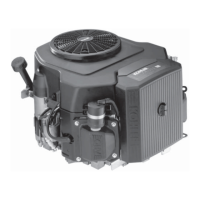Disassembly/Inspection and Service
4362 690 02 Rev. D KohlerEngines.com
Clean all parts thoroughly as engine is disassembled.
Only clean parts can be accurately inspected
and gauged for wear or damage. There are many
commercially available cleaners that will quickly remove
grease, oil and grime from engine parts. When such a
cleaner is used, follow manufacturer’s instructions and
safety precautions carefully.
Make sure all traces of cleaner are removed before
engine is reassembled and placed into operation. Even
small amounts of these cleaners can quickly break down
lubricating properties of engine oil.
Disconnect Spark Plug Leads
NOTE: Pull on boot only, to prevent damage to spark
plug lead.
1. Disconnect leads from spark plugs.
2. Shut off fuel supply.
Drain Oil from Crankcase and Remove Oil Filter
1. Clean oil fi lter and housing area. Remove and
discard oil fi lter.
2. Remove dipstick and 1 oil drain plug.
3. Allow ample time for oil to drain from crankcase.
Remove Muffl er
Remove exhaust system and attaching hardware from
engine.
Remove Cylinder Shrouds and Blower Housing
1. Remove top mounting screw and loosen shoulder
screws on each side. Lift off cylinder shrouds.
2. Remove mounting screws and separate blower
housing from backing shroud assembly. One screw
also secures oil fi ll/dipstick tube. Fixed guard (if
equipped) may be removed with blower housing.
3. Remove lower mounting screw and pull oil fi ll tube
out of crankcase.
Remove Electric Starter Motor
1. Disconnect leads from starter.
2. Remove screws and starter.
Remove Air Cleaner Assembly
1. Disconnect breather hose from air cleaner and
formed vent hose from vent port on carburetor.
2. Remove nuts and ground lead from mounting studs.
3. Remove screws securing air cleaner and main
control bracket to intake manifold bosses.
4. Remove air cleaner as an assembly from engine.
Remove Fuel Pump
WARNING
Explosive Fuel can cause fi res and severe
burns.
Do not fi ll fuel tank while engine is hot or
running.
Gasoline is extremely fl ammable and its vapors can
explode if ignited. Store gasoline only in approved
containers, in well ventilated, unoccupied buildings,
away from sparks or fl ames. Spilled fuel could ignite
if it comes in contact with hot parts or sparks from
ignition. Never use gasoline as a cleaning agent.
NOTE: Based on style of fuel pump used refer to
following.
Pulse Style Fuel Pump
Pulse style fuel pump is mounted to side of control
bracket. It may be removed separately or with bracket.
To remove separately:
1. Remove mounting screws securing fuel pump to
control bracket.
2. Disconnect inlet, outlet, and pulse (vacuum) hoses
and remove fuel pump. Properly contain any
remaining fuel.
Electric Fuel Pump
Removal will be determined based on mounted location
and application. Disconnect lead connections, fuel
line connections, and mounting hardware as required.
Properly contain any remaining fuel.
Remove Control Bracket, Governor Springs, and
Lever
1. Unhook governed idle and governor springs from
controls on main bracket and governor lever. Note
color, location, and position of each.
2. Disconnect throttle linkage and dampening spring
from governor lever at small bushing.
3. Carefully pry off pal nut, remove washers (note
assembly order), and disconnect choke linkage from
pivot lever. Do not lose any parts. Secure remaining
pivot parts with tape to avoid losing them. Always
use a new pal nut during reassembly.
4. If fuel pump is being removed with bracket,
disconnect pulse (vacuum) hose and outlet fuel hose
from pulse pump. Properly contain any remaining
fuel.
5. Remove lower mounting screw going into intake
manifold and remove main control bracket.
6. Loosen nut and remove governor lever from cross
shaft.

